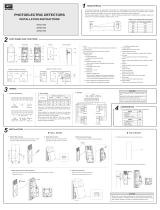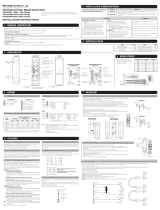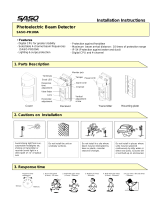Page is loading ...

1
On working mode(non-programming mode),
press programming switch, can open or close
signal strength indicator. Open signal indicator
when adjusting,after that ,close indicator for
saving power .
Switch Tra/Rec
DIP1
DIP2
DIP3
DIP4
DIP5
Frequency switch
No
No
Buzzer switch
POWER DC13.8V-24V(NON-POLAR)
ABT-
TRANSMITTER
MODEL
LOT.
POWER
MODEL
POWER DC13.8V-24V(NON-POLAR)
ABT-
RECEIVER
LOT.
POWER
123
45
LH
ALARM
Power indicator
Power supply
Alarm Test hole
Signal strength indication
State
. Parts Name
Housing
Vertical fine-tune knob
Wiring terminal
Tamper switch
Indicator
Lens
Voltage test hole
Response time
Adjustment knob
Receiving box Housing locking screw
Viewfinder
Bracket
Collimation hole
Grade
On on o n on on G 1 0
On on on on twinkle G 9
Off o n on on o n G 8
Off on on on twinkle G 7
Off o ff on on on G 6
Off off on on twinkle G 5
Off off off on on G4
Off off off on twinkle G 3
Off o ff of f off o n G 2
Off off off off twinkle G1
Off off off off off G0
Signal strength indication (11 grades)
Suggested over 7 grades
Signal strength indication
(LED5-LED1)
Technical parameters:
Model ABT-20
20m
60m
ABT-30
30m
60m
ABT-40
40m
120m
ABT-60
60m
180m
ABT-80
80m
240m
ABT-100
100m
300m
No. of beams
Detection mode
Optical source
Response speed
Alarm output
Power supply
Operation temperature & humidity
Dimensions
Tamper output
Optical axis adjustment(H)
Optical axis adjustment(V)
Protection against dew, frost
Material
Net weight
Gross
Alert distance
Outdoor
Indoor
Calefaction housing (optional)
PC resin
658g(receiver +transmitter)
1150g
2 beams
2 beams blocked simultaneous
Infrared digital pulse beam
Relay contact output: NO. NC contact rating: AC/DC30V 30AMax
Contact output: NC contact rating DC24V 0.5Amax
Refer to its diagram
20(10)
50-240ms
DC13.8-24V 15W
RECEIVER
TRANSMITTER
-25-55 5-95%RH (relative humidity)
180 ( 90 )
No

2
50mm
50mm
. Precautions for setting
Impediment presents during setup
receiver
transmitter
receiver
transmitter
Multi sensors may be used for long-distance
guarding. Please install according to the below
diagram to avoid interference between beams.
The base is unstable
receiver
transmitter
transmitter
receiver
Horizontal 180 ( 90 ) Vertical 10
Direct sunlight, lamplight etc.
Detection distance
Beam spread diameter
Style
ABT-20
ABT-30
ABT-40
ABT-60
ABT-80
ABT-100
Guarding distance Beam spread diameter
20m
30m
40m
60m
80m
100m
0.6m
0.7m
1.0m
1.5m
1.8m
2.1m

6Setting of transmitter data
1 2 3 4
Frequencies selection
3
PowerPower
OFF
ON
OFF
ON
TamperTamper
77
881122
33
44
55
66
NCNC
Frequency list
DIP 12345678
1
2
3
ON OFF ON OFF ON OFF ON OFF
OFF ON ON OFF OFF ON ON OFF
OFFOFF OFF OFF ONON ON ON
Empty
240240 5050
Response time adjustmentResponse time adjustment
Trouble Trouble PowerPower
AlarmAlarm
TamperTamper
77
8899
1010
1212 1111 1122
33
44
55
66
OFF
ON
OFF
ON DIP
15mm
Programming switch
7Setting of receiver data
Receiver adopts electronic memory chip to store data,so it is not with DIP switch. Setting of receiving frequency and NO/NC.
7.1 Status shift diagram
Keep pressing the tamper for
3 times within 3 seconds, wh-
en there are beep beep..
sound for tow times, it enters
to parameter setting status.
Enter status of receiving frequency bands and NO/NC
Alarm light (siren): send out sound 2 times
periodically, at this time, LED4 displays
NO/NC, LED3-LED1 display receiving bands.
Each receipt, the function switch LED4-LED1
add address 1 and auto re-circle.
If function switch is not operated over 10 seconds
Working status
Non-alarm: alarm light
NC, siren no sound
Alarm: alarm light NO,
siren keep sounding.
7.2 Setting diagram for receiver
bands and alarm relay NC/NO.
Press programming switch in 3 secretary
1
2
3
4
5
6
7
8
1
8
0 0 0
4 3 2 1
Signal LED
0 0 1
0 1 0
0 1 1
1 0 0
1 0 1
1 1 0
1 1 1
0 0 0
1 1 1
Note 1=NO 0=NC
1.Remove the cover 2.Attach the paper stencil onto the location
where the equipment is to be mounted, and
drill the holes in the positions on its mark.
3.Put the cable through the
hole for wiring.
4.Fix the main body onto the wall 5.Connect the cable to the wire terminal.
.Setting procedure
Wiring hole
TRANSMITTER
RECEIVER
TRANSMITTER
Frequencies
During operation status, press the tamper switch by 3 times within 3 seconds, when there are two long beep sound, it ent-
ers to parameter setting status, in this status, siren and alarm light will send out 1 sounds periodical-ly in order to mention
that it is in the part of parameter setting.
ON/OFF Signal strength indicator
One long beep sound means setting is ended and
automatic memory finished, returns to working status.
Bands
OFF
OFF
OFF
OFF
OFF
OFF
OFF
OFF
ON
ON
Note: when power is supplied, equipment address and frequency bands setting data for 10
seconds automatically, and alarm light (siren) will offer relevant indication. And then
it enters to operation status.

4
Installation of fixed bracket
8.1.Drill a hole on the bracket and
extend out the cable from it.
8.2.Remove the cover.
8.3.Fasten the base-plate
to the bracket.
(Back-to-back installation guiding diagram)
8.Put on the cover after adjusting the response time of the beam.
. Beam alignment
5.2.Adjust the vertical adjustment screw and the horizontal
angle adjusting wheel in order that the image of opposite
detector falls into the central part of the viewing hole. At
this time, the GOOD indicator of receiver shall light up;
if not, adjust it repeatedly.
Vertical adjustment screw
down up
horizontal adjustment bracke
1. Insert the test pen into the test hole (please note the +,-
polarity)
2. First adjust the horizontal angle until the test hole voltage
output maximize. Then adjust the vertical angle by the sa-
me way till the voltage reaches the value above that of be-
low diagram.
3. If it can't reach 1.1V or higher voltage, the transmitter and
receiver shall be regulated again.
Multimeter selects DC 10V
5.1.Observe the collimation effect at a distance of 5cm
from the collimator.

5
Min
Max
Green LED light up shows transmitting
Transmitting
In anti-fog state
Transmitter and receiver are not in same frequency
State LED on,alarm LED on
State LED off,alarm LED off
Beams are blocked,alarm state
State LED off,alarm LED on
State LED on,alarm LED off
Normal state
. Beam response time adjustment
Please see the diagram to
adjust the response time of
the receiver. Usually, the
time set shall be less than
the time when the intruder
crosses the guarding area.
High speed:1 (6.9m/s) Fast running:2(4m/s)
Fast walking(1.2m/s):3 Normal walking(0.7m/s):4 Slow walking(0.4m/s):5
.Physical test
Walking test is required after the setting, physical test in accordance to below diagram.
Transmitter
Receiver
State Signal

6
Trouble checking
Fault Cause Solution
Check the power wiring
The LED of the transmitter doesn't light up Power failure (open circuit, short-circuit, etc.)
Check the power wiring
The LED of the receiver doesn't light up Power failure (open circuit, short-circuit, etc.)
1.By reflecting, or light from other sources enter the
receiver
2.Both beams are not blocked at the same time
3.Response time is set too short
The LED of the receiver doesn't light up
when the light is blocked
1.Remove the reflecting object or change the
direction of beam
2. Block both beams at the same time
3.Prolong the response time
The receiver alarm indicator ON after the
beam is blocked, but there is NO alarm
signal output
1.Broken circuit or short-circuit of the wiring
2.Poor contact
1.Check the wiring and contact
2.Connect the cable
The alarm indicator of the receiver is
constantly ON.
1.The beam doesn't match closely
2.There is obstacle presents between the transmitter
and the receiver
3.The cover is polluted.
1.Re-adjust the beam
2.Remove the obstacle
3.Clear the cover
Intermittent alarm signal output
1.Improper wiring
2.The supply voltage does not reach 13V or higher
3.The potential obstacle appears to block the beams
due to the effect of wind and rain
4.The installation base unstable
5.The beam coincidence accuracy is inadequate
6.Beams blocked by other moving objects
7.Response time too short
8.Level 5 LED does not light up before the cover is
put on
1.Check the wiring
2.Check the supply power
3.Remove the obstacle or change the location
4.Select a site with a stable base
5.Re-adjust the optical axis
6.Adjust the shade time or change the install location
7.Re-adjust the response time
8.Re-adjust the optical axis, and make the signal
reception reaches its top.
Recommended installation guide & physical appearance and dimension
Installation bracket
I-shaped bracket
I-100
100mm
I-200
200mm
T-shaped bracket
T-100
100 120mm
T-200
200 120mm
Dimensions
L-shaped bracket
85 75mm
/






